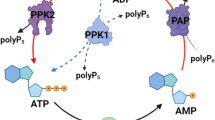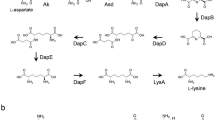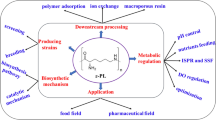Abstract
The antibacterial polymer ɛ-poly-l-lysine (ε-PL) has been widely used as a safe food preservative. As the synthesis of ε-PL requires a rich supply of nitrogen, the efficiency of nitrogen translocation and utilization is extremely important. The objective of this study was to improve the production of ε-PL by overexpressing the ammonium transporter gene amtB in Streptomyces albulus PD-1. Using the recombinant bacteria, the optimum carbon-to-nitrogen ratio in the synthesis stage of fermentation increased from 3 to 4.71, compared with that obtained using the wild-type strain, and the utilization efficiency of ammonium was improved too. Ultimately, the production of ε-PL increased from 22.7 to 35.7 g/L upon fed-batch cultivation in a 5 L bioreactor. Determination of the expression of the genes and enzymes associated with ammonium metabolism and ε-PL synthesis revealed that the overexpression of amtB in S. albulus PD-1 enhanced ε-PL biosynthesis by increasing the activity of the corresponding metabolic pathways. To the best of our knowledge, this is the first report on enhancing ε-PL production by overexpression of the amtB gene in an ε-PL-producing strain.





Similar content being viewed by others
References
Xu Z, Xu Z, Feng X, Xu D, Liang J, Xu H (2016) Recent advances in the biotechnological production of microbial poly(ɛ-l-lysine) and understanding of its biosynthetic mechanism. Appl Microbiol Biotechnol 100:6619–6630
Hiraki J, Ichikawa T, Ninomiya S, Seki H, Uohama K, Seki H, Kimura S, Yanagimoto YBJ Jr (2003) Use of adme studies to confirm the safety of epsilon-polylysine as a preservative in food. Regul Toxicol Pharmacol 37:328–340
Pandey AK, Kumar A (2014) Improved microbial biosynthesis strategies and multifarious applications of the natural biopolymer epsilon-poly-L-lysine. Process Biochem 49:496–505
Hirohara H, Takehara M, Saimura M, Ikezaki A, Masayuki A, Miyamoto M (2006) Biosynthesis of poly(epsilon-l-lysine)s in two newly isolated strains of streptomyces sp. Appl Microbiol Biotechnol 73:321–331
Yoshida T, Nagasawa T (2003) Epsilon-poly-l-lysine: microbial production, biodegradation and application potential. Appl Microbiol Biotechnol 62:21–26
Xu D, Yao H, Xu Z, Wang R, Xu Z, Li S, Feng X, Liu Y, Xu H (2017) Production of ɛ-poly-lysine by Streptomyces albulus PD-1 via solid-state fermentation. Bioresour Technol 223:149–156
Cai L, Tabata H, Kawai T (2001) Probing electrical properties of oriented DNA by conducting atomic force microscopy. Nanotechnology 12:211–216
Laurinavicius V, Kurtinaitiene B, Liauksminas V, Ramanavicius A, Meskys R, Rudomanskis R, Skotheim T, Boguslavsky L (1999) Oxygen insensitive glucose biosensor based on PQQ-dependent glucose dehydrogenase. Anal Lett 32:299–316
Shih IL, Shen MH, Van YT (2006) Microbial synthesis of poly(ε-lysine) and its various applications. Bioresour Technol 97:1148–1159
Wang R, Li J, Chen W, Xu T, Yun S, Xu Z, Xu Z, Sato T, Chi B, Xu H (2017) A biomimetic mussel-inspired ε-poly-l-lysine hydrogel with robust tissue-anchor and anti-infection capacity. Adv Funct Mater 27:1604894
Evans HJ, Bottomley PJ, Newton WE (1985) Nitrogen fixation research progress. Springer, Netherlands
Merrick MJ, Edwards RA (1996) Nitrogen control in bacteria. Microbiol Rev 59:604–622
Hodgson DA (2000) Primary metabolism and its control in streptomycetes: a most unusual group of bacteria. Adv Microb Physiol 42:47–238
Mart Xed JF (2004) Phosphate control of the biosynthesis of antibiotics and other secondary metabolites is mediated by the PhoR-PhoP system: an unfinished story. J Bacteriol 186:5197–201
Shih IL, Shen MH (2006) Application of response surface methodology to optimize production of poly-ɛ-lysine by Streptomyces albulus IFO 14147. Enzym Microb Technol 39:15–21
Chen X, Tang L, Li S, Liao L, Zhang J, Mao Z (2011) Optimization of medium for enhancement of ε-poly-l-lysine production by Streptomyces sp. M-Z18 with glycerol as carbon source. Bioresour Technol 102:1727–1732
Liu SR, Wu QP, Zhang JM, Mo SP (2015) Efficient production of ε-poly-l-lysine by Streptomyces ahygroscopicus using one-stage pH control fed-batch fermentation coupled with nutrient feeding. J Microbiol Biotechnol 25:358–365
Sanchez S, Demain AL (2002) Metabolic regulation of fermentation processes. Enzyme Microb Technol 31:895–906
Ren XD, Chen XS, Tang L, Zeng X, Wang L, Mao ZG (2015) Physiological mechanism of the overproduction of ε-poly-l-lysine by acidic pH shock in fed-batch fermentation. Bioprocess Biosyst Eng 38:2085–2094
Reuther J, Wohlleben W (2007) Nitrogen metabolism in streptomyces coelicolor: transcriptional and post-translational regulation. J Mol Microbiol Biotechnol 12:139–146
Detsch C, Stülke J (2003) Ammonium utilization in bacillus subtilis: transport and regulatory functions of nrgA and nrgB. Microbiology 149:3289–3297
Ren XD, Chen XS, Zeng X, Wang L, Tang L, Mao ZG (2015) Acidic pH shock induced overproduction of ε-poly-l-lysine in fed-batch fermentation by Streptomyces sp.M-Z18 from agro-industrial by-products. Bioprocess Biosyst Eng 38:1113–1125
Sindelar G, Wendisch VF (2007) Improving lysine production by corynebacterium glutamicum through dna microarray-based identification of novel target genes. Appl Microbiol Biotechnol 76:677–689
Meng S, Wu H, Wang L, Zhang B, Bai L (2017) Enhancement of antibiotic productions by engineered nitrate utilization in actinomycetes. Appl Microbiol Biotechnol 101:1–12
Kieser T, Bibb MJ, Buttner MJ, Chater KF, Hopwood DA (2000) Practical Streptomyces genetics. The John Innes Foundation, Norwich
Lu Q (2005) Seamless cloning and gene fusion. Trends Biotechnol 23:199–207
Xu Z, Cao C, Sun Z, Li S, Xu Z, Feng X, Xu H (2015) Construction of a genetic system for Streptomyces albulus PD-1 and improving poly(ε-l-lysine) production through expression of Vitreoscilla hemoglobin. J Microbiol Biotechnol 25:1819–1826
Zhou YP, Ren XD, Wang L, Chen XS, Mao ZG, Tang L (2015) Enhancement of ε-poly-lysine production in ε-poly-lysine-tolerant Streptomyces sp. by genome shuffling. Bioprocess Biosyst Eng 38:1705–1713
Kahar P, Iwata T, Hiraki J, Park EY, Okabe M (2001) Enhancement of ε-polylysine production by streptomyces albulus strain 410 using pH control. J Biosci Bioeng 91:190–194
Xia J, Xu Z, Xu H, Feng X, Bo F (2014) The regulatory effect of citric acid on the co-production of poly(ε-lysine) and poly(l-diaminopropionic acid) in streptomyces albulus PD-1. Bioprocess Biosyst Eng 37:2095–2103
Xu Z, Bo F, Xia J, Sun Z, Li S, Feng X, Xu H (2015) Effects of oxygen-vectors on the synthesis of epsilon-poly-lysine and the metabolic characterization of Streptomyces albulus PD-1. Biochem Eng J 94:58–64
Livak KJ, Schmittgen TD (2001) Analysis of relative gene expression data using real-time quantitative PCR and the 2−∆∆Ct method. Methods 25(4):402–408
Wang G, Hosaka T, Ochi K (2008) Dramatic activation of antibiotic production in streptomyces coelicolor by cumulative drug resistance mutations. Appl Microbiol Biotechnol 74:2834–2840
Zhou TC, Kim BG, Zhong JJ (2014) Enhanced production of validamycin a in streptomyces hygroscopicus 5008 by engineering validamycin biosynthetic gene cluster. Appl Microbiol Biotechnol 98:7911–7922
Ertan H (1992) Some properties of glutamate dehydrogenase, glutamine synthetase and glutamate synthase from corynebacterium callunae. Arch Microbiol 158:35–41
Chen XS, Mao ZG (2013) Comparison of glucose and glycerol as carbon sources for ε-poly-L-lysine production by streptomyces sp. M-Z18. Appl Biochem Biotechnol 170:185–197
Gu Y, Wang X, Yang C, Geng W, Feng J, Wang Y, Wang S, Song C (2016) Effects of chromosomal integration of the vitreoscilla hemoglobin gene (vgb) and s-adenosylmethionine synthetase gene (metk) on ε-poly-L-lysine synthesis in streptomyces albulus NK660. Appl Biochem Biotechnol 178:1445–1457
Hamano Y, Nicchu I, Shimizu T, Onji Y, Hiraki J, Takagi H (2007) ɛ-poly-l-lysine producer, streptomyces albulus, has feedback-inhibition resistant aspartate kinase. Appl Microbiol Biotechnol 76:873–882
Wu H, Liu W, Dong D, Li J, Zhang D, Lu C (2014) Slnm gene overexpression with different promoters on natamycin production in streptomyces lydicus A02. J Ind Microbiol Biotechnol 41:163–172
Zheng ZY, Jiang Y, Zhan XB, Ma LW, Wu JR, Zhang LM, Lin CC (2014) An increase of curdlan productivity by integration of carbon/nitrogen sources control and sequencing dual fed-batch fermentors operation. Prikladnaia Biokhimiia I Mikrobiologiia 50:35–42
Xu N, Zhang X, Xiao F, Han L, Zeng C (2001) Effects of nitrogen source and concentration on growth rate and fatty acid composition of Ellipsoidion sp. (eustigmatophyta). J Appl Phycol 13:463–469
Yang J, Zhou X, Zhang Y (2004) Improvement of recombinant hirudin production by controlling NH4 +, concentration in pichia pastoris, fermentation. Biotechnol Lett 26:1013–1017
Cheng P, Wang Y, OseiWusu D, Wang Y, Liu T (2018) Development of nitrogen supply strategy for scenedesmus rubescens attached cultivation toward growth and lipid accumulation. Bioprocess Biosyst Eng 41:435–442
Xia J, Xu Z, Xu H, Liang J, Li S, Feng X (2014) Economical production of poly (ε-l-lysine) and poly (l-diaminopropionic acid) using cane molasses and hydrolysate of streptomyces cells by Streptomyces albulus PD-1. Bioresour Technol 164:241–247
Glibert PM, Wilkerson FP, Dugdale RC, Raven JA, Dupont CL, Leavitt PR, Parker AE, Burkholder JM, Kana TM (2016) Pluses and minuses of ammonium and nitrate uptake and assimilation by phytoplankton and implications for productivity and community composition, with emphasis on nitrogen-enriched conditions. Limnol Oceanogr 61:284–300
Tiffert Y, Supra P, Wurm R, Wohlleben W, Wagner R, Reuther J (2008) The streptomyces coelicolor glnr regulon: identification of new glnr targets and evidence for a central role of glnr in nitrogen metabolism in actinomycetes. Mol Microbiol 67:861–880
Amon J, Titgemeyer F, Burkovski A (2010) Common patterns-unique features: nitrogen metabolism and regulation in gram-positive bacteria. Fems Microbiol Rev 34:588–605
Tesch M, Graaf AAD, Sahm H (1999) In vivo fluxes in the ammonium-assimilatory pathways in Corynebacterium glutamicum studied by 15N nuclear magnetic resonance. Appl Environ Microbiol 65:1099–1109
Huang B, Qin P, Xu Z, Zhu R, Meng Y (2011) Effects of cacl2, on viscosity of culture broth, and on activities of enzymes around the 2-oxoglutarate branch, in bacillus subtilis, CGMCC 2108 producing poly-(γ-glutamic acid). Bioresour Technol 102:3595–3598
Takehara M, Hibino A, Saimura M, Hirohara H (2010) High-yield production of short chain length poly(ε-L-lysine) consisting of 5–20 residues by streptomyces aureofaciens, and its antimicrobial activity. Biotechnol Lett 32:1299–1303
Gottschalk G (1986) Bacterial metabolism, 2nd edn. Springer, New York
Acknowledgements
This work was supported by the National Key R&D Program of China (No. 2017YFD0400400), the National Nature Science Foundation of China (Nos. 21476112 and 51703095), the China Postdoctoral Science Foundation (No. 51229018), the State Key Laboratory of Materials-Oriented Chemical Engineering (No. KL15-09 to J. Zhou), and the Key Projects in the National Science & Technology Pillar Program during the Twelfth Five-year Plan Period (No. 2015BAD15B04), the Jiangsu Synergetic Innovation Center for Advanced Bio-Manufacture (No. XTB1804).
Author information
Authors and Affiliations
Corresponding authors
Rights and permissions
About this article
Cite this article
Xu, D., Yao, H., Cao, C. et al. Enhancement of ε-poly-l-lysine production by overexpressing the ammonium transporter gene in Streptomyces albulus PD-1. Bioprocess Biosyst Eng 41, 1337–1345 (2018). https://doi.org/10.1007/s00449-018-1961-9
Received:
Accepted:
Published:
Issue Date:
DOI: https://doi.org/10.1007/s00449-018-1961-9




